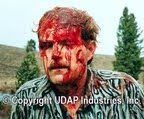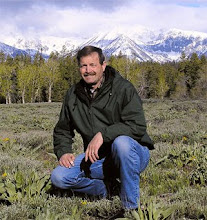Livingston/L.A. stuntman develops backpack bear spray
March 07, 2015 5:00 pm • By Brett French
The Back Attack Pack is deployed by a ripcord attached to the front of the backpack, somewhat like a parachute ripcord. It may sound contradictory, but the people taking the biggest risks are usually the most safety conscious.
Take Billy Lucas, for example. For 30 years the 57-year-old former Marine has been a Hollywood stuntman — part of that acting as Arnold Schwarzenegger’s stunt double in films like “True Lies” and “The Terminator” series of films. So the fact that Lucas brainstormed a design for a new way to deploy bear spray from a backpack actually makes sense. He is very aware of ways to mitigate danger.
“There are no bragging rights in getting hurt,” Lucas said. “Safety is a primary concern, especially in my business.”
And stuntmen who get hurt aren’t going to be available to work, so there’s a monetary incentive for them to be careful.
‘Brainstorm’
Knowing this, it’s a natural progression to the story Lucas tells about one day reading a newspaper story about a man being mauled to death by a bear and wondering if there isn’t a better way to deter attacks. Lucas had recently made the move to Livingston from Los Angeles when the incident occurred. Then he had his own encounter with a bear while fishing with friends and admitted to being spooked.
So Lucas read up on other bear attacks and noticed that when people dropped into defensive positions — lying face-down and covering their necks — they were still very vulnerable.
Lucas said the idea of a reserve parachute gave him the idea of a backpack-based bear spray canister that could be discharged much like pulling the ripcord on a parachute.
“I had a brainstorm and put my money where my mouth was,” he said, paying an engineer to design the first prototype out of aluminum before deciding that was too heavy and going to plastic.
“I like working with my hands and problem solving,” he said. “It’s one of those things that came late in life to me.”
He said he has a couple of other inventions he’s working on as well.
R and D
After three years in research and development, Lucas approached Butte-based bear spray makers UDAP Industries with his invention.
Tim Lynch, general manager for UDAP, said it was a concept other inventors had presented to the company, but UDAP never made the jump to do its own research and development. Lucas was different.
“When he showed up he had a working prototype, which the other inventors didn’t,” Lynch said.
He was so impressed that he shot a video of the backpack to show the bloody face of the bear spray business to the company’s founder, Mark Matheny. After reaching a licensing and distribution deal, last April UDAP unveiled its Back Attack Pack ($149) that can accommodate spray canisters of different sizes and be lashed on to a variety of backpacks.
“It’s exciting to go into a store and see something hanging on the shelf that you’ve built,” Lucas said. “That’s pretty cool.”
Last shot
The backpacks are made to be a secondary or last defense — used in addition to a handheld bear spray.
Lynch said he sees the device as a valuable backup for hunters — who while dressing game can be blindsided from behind by a territorial bear looking to claim a big-game kill. He said an Alaskan study showed that in the majority of bear-human encounters, the person had only 1.8 seconds to react. That’s barely enough time to pull the trigger on a bear spray canister in your hand, so a backup seems like a good idea.
“This is designed to get that bear off your back,” Lynch said. “It’s not to replace spray, but in addition to it. This is sort of a backup, like a reserve parachute.”
To view the original story in the Billings Gazette... Click the following link:
http://billingsgazette.com/lifestyles/recreation/livingston-l-a-stuntman-develops-backpack-bear-spray/article_33e9c463-dbff-5f5f-a197-e02016127fe7.html
To order the Back Attack Pack or learn more visit:
www.BearSpray.com





mlTQBmk~$(KGrHqR,!h4Eyc!7o4cgBMy,UnsuEQ~~-1_35.GIF)






